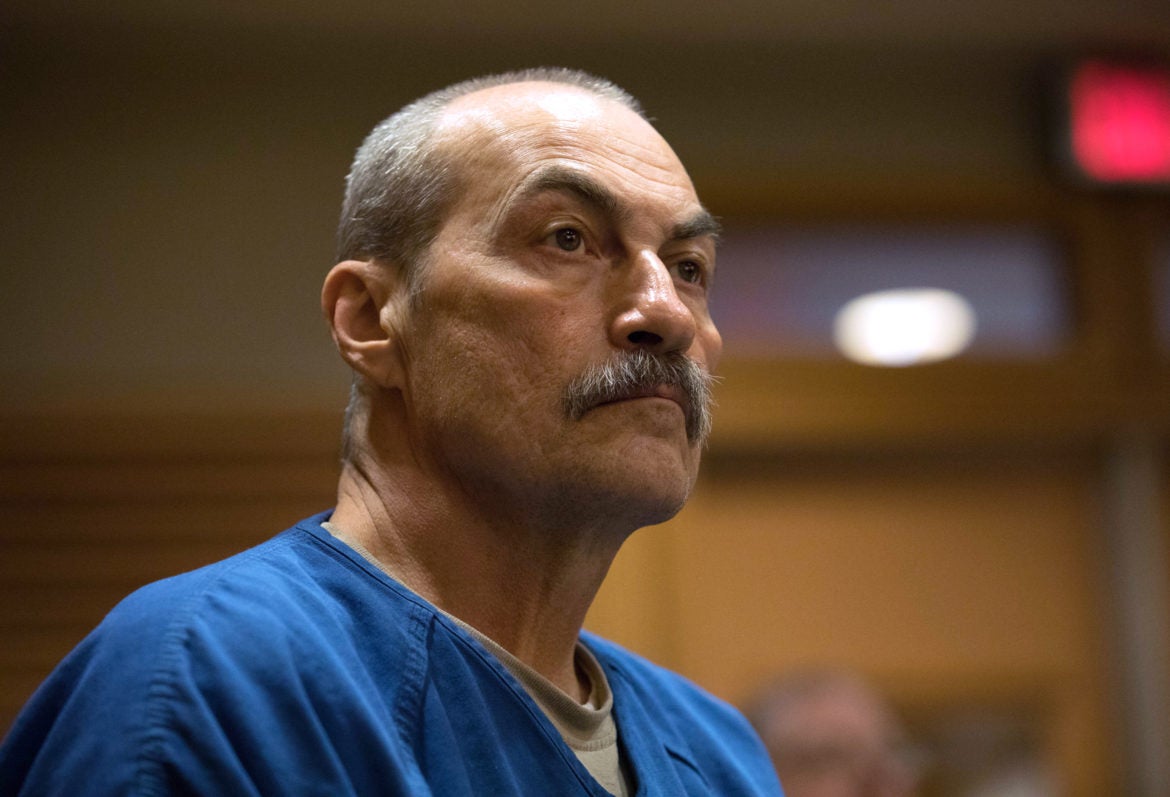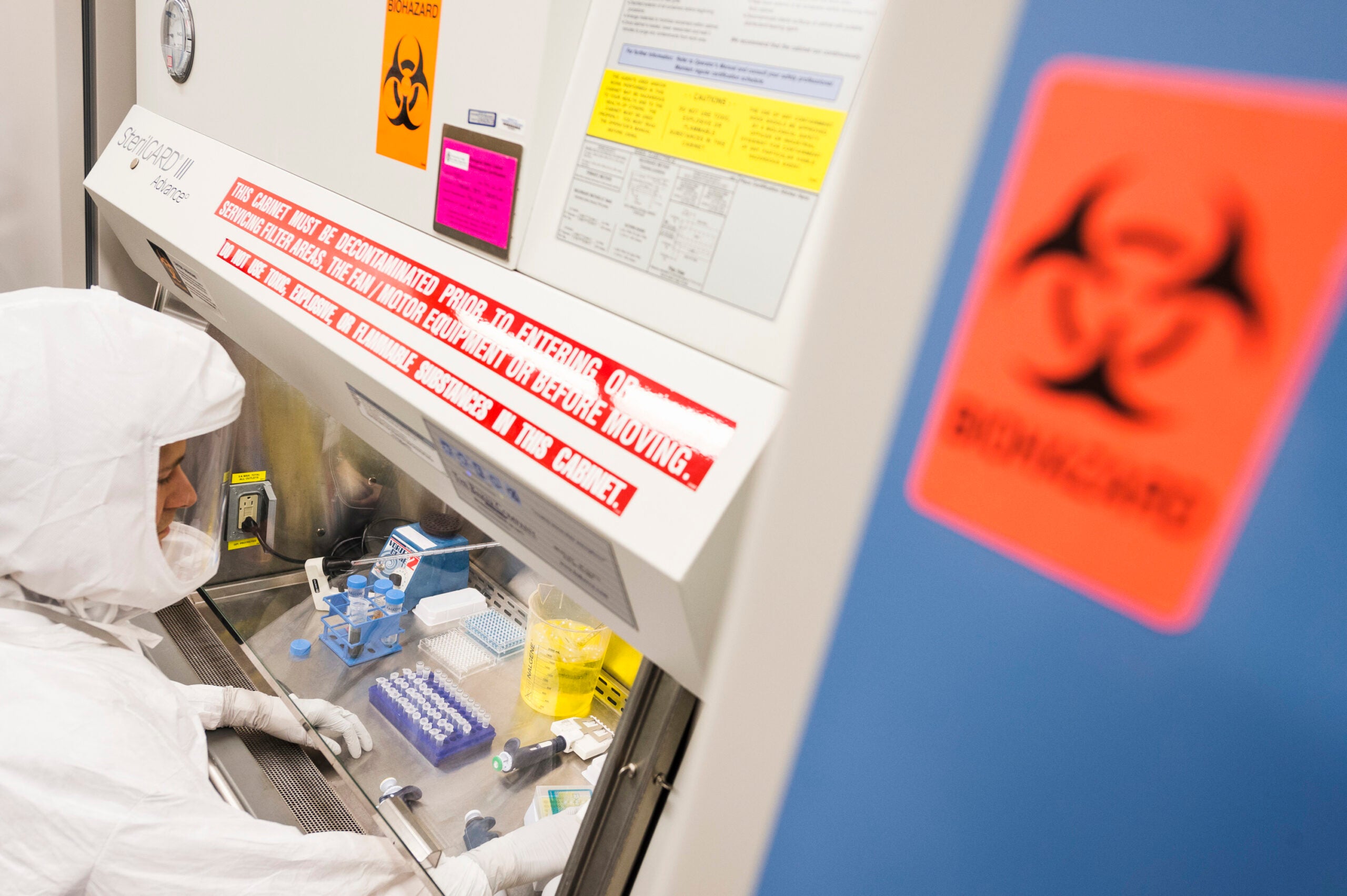The 28-year-old mother of two was raped by a stranger in her home in rural Stoughton. Before the attack, the woman was followed around town and received menacing, sexually charged phone calls from an unknown man, whom she suspected lived nearby.
Nearly two years after the 1987 rape, Richard Beranek — who was living 130 miles away and had no known ties to the community — surfaced as a possible suspect. Chippewa County law enforcement officials thought Beranek, facing sexual assault charges there, resembled a composite sketch of the suspect in the Stoughton rape.
The woman picked Beranek out of a group of photos, telling police she was almost certain he was the attacker. She then picked Beranek out of a live lineup.
Stay informed on the latest news
Sign up for WPR’s email newsletter.
Sealing Beranek’s fate, FBI analyst Wayne Oakes concluded a hair found in underwear left by the rapist in the woman’s bed was a “match” to Beranek’s hair “to a high degree of probability.”
At the time, however, the FBI knew microscopic hair comparison had limitations. Hair that looks identical, even under a high-powered microscope, could come from a number of individuals. That did not stop Oakes.
Even though multiple witnesses testified Beranek was hundreds of miles away at the time of the crime, the jury found him guilty on nine felony counts. Dane County Circuit Judge Daniel Moeser sentenced him as a repeat offender to 243 years in prison.
DNA Excludes Beranek
While Beranek remains imprisoned, the way the FBI used microscopic hair comparison has been discredited in hundreds of cases nationwide, including Beranek’s.
DNA testing has now excluded Beranek, 58, as the source of the hairs found in the perpetrator’s underwear and of sperm from the victim’s underwear, according to a motion for a new trial filed in 2016 by attorneys with the New York-based Innocence Project and the Wisconsin Innocence Project.
The Beranek case is among an estimated 3,000 slated for re-examination in which FBI hair or fiber analysis was used before 2000 when DNA testing became widely available. So far, 1,600 have been reviewed, said Vanessa Antoun, an attorney with the National Association of Criminal Defense Lawyers, who is participating in the effort.
The ongoing review has found problems in more than 90 percent of the cases, including 13 in Wisconsin.
The agency’s misuse of hair evidence to convict people is “a national tragedy” and a violation of human rights, said Frederic Whitehurst, the whistleblower who revealed scientific misconduct including flawed hair analysis at the FBI laboratory in the 1990s.
“We go into court with unvalidated science,” Whitehurst said. “We know it’s unvalidated science. The world of science is saying this is not valid, and we actually use this pseudo science against citizens of this nation.”

Richard Beranek with attorney, Archie Simonson, in Dane County Circuit Court in 1989. Scott Seid/Wisconsin State Journal
Testimony Powerful — And Wrong
Oakes had told jurors that “rarely, extremely rarely” was he unable to tell two hairs apart and the suspect’s hair and Beranek’s were “microscopically the same.” He claimed he had examined “billions” of hairs. To reach even 1 billion, Oakes would have needed to analyze 322,321 hairs a day, 365 days a year during his eight and a half years in the FBI hairs and fibers unit.
Further bolstering his case, Oakes said a more experienced analyst at the FBI, Michael Malone — whom he described as having near flawless ability to compare hair samples — had confirmed the match.
Six witnesses, however, placed Beranek 600 miles away at the time of the rape, at the home of his sister and her husband in Devils Lake, North Dakota. Four Beranek family members and two non-family members confirmed he was in North Dakota. A food stamp application introduced at trial showed his sister had listed Beranek as a member of her household around the time the rape occurred.

Sketch, left, produced in 1987 by the Dane County Sheriff’s Office based on victim’s description of her attacker. At right is a photo of Richard Beranek. Dane County Circuit Court
Dane County Assistant District Attorney Robert Kaiser had the powerful FBI testimony on his side, however. He drove home its importance during closing arguments in the 1990 trial.
“What an incredible coincidence,” Kaiser told the jurors. “Somehow (the victim) managed to pick out of a photo array someone in 10,000 people who had a hair that matched a hair that happened to be in her house from some unknown place.”
In 2015, the FBI acknowledged Oakes’ testimony in Beranek’s case included “erroneous statements“in which he said or implied the hair found at the scene “could be associated with a specific individual to the exclusion of all others.” Those statements “exceeded the limits of science,” the FBI now says.
Skip Palenik, founder of Microtrace LLC of Elgin, Illinois, testified at a recent evidentiary hearing that Oakes’ statements in the Beranek case violated professional standards in place even back then. Palenik has more than 40 years’ experience in the field of finding, analyzing and comparing materials, including those found in minute amounts.
Absent DNA testing, hair is not unique enough to be tied to one person, he said. Two strands of hair that appear identical could be from the same person, Palenik said. Or just as likely, they could be from two people “with the same type of hair,” he said.
“You can’t individualize to a certain person by microscopy,” Palenik said. “We thought you could, but we can’t.”
Hair Cases Under Review
The Wisconsin Center for Investigative Journalism has learned that among the 19 reviewed cases are the 1995 prosecution of Patrick W. Greer in La Crosse County in which numerous errors were identified; and the 1985 case brought against Glenn Lale in Walworth County, in which no errors were identified.
Records provided by the Wisconsin Department of Justice under the public records law also mention a third unnamed case from McHenry County, Illinois, which has a tie to Vilas County.
In addition to the FBI cases, there are 15 cases in which Wisconsin State Crime Laboratory analysts trained by the now-discredited FBI hairs and fibers unit performed microscopic hair comparisons, according to the DOJ. Those cases are not part of the FBI review.

Hair under a microscope. Courtesy of Microtrace LLC
Although the FBI had been slowly re-examining hair cases since the 1990s, the effort accelerated in 2012 after three men from Washington, D.C. — Donald Eugene Gates, Kirk Odom and Santae Tribble — were exonerated by DNA testing that contradicted hair evidence offered by FBI experts, including Malone. The Innocence Project and the NACDL are part of the stepped up review.
Not all defendants whose cases included flawed hair analysis are innocent. But it is a significant factor in wrongful convictions nationwide. Defendants in about one-fifth of exonerations by DNA evidence were convicted at least in part on hair analysis that turned out to be wrong, according to the NACDL.
In some instances, hair testimony and analysis by the FBI, although faulty, may be immaterial to the conviction.
That was not the case for George Perrot, who was linked by a single hair to a burglary and rape in Springfield, Massachusetts.
Oakes — the analyst who testified in the Beranek case — gave scientifically invalid testimony in that case, too, the FBI found. Perrot’s conviction was overturned in 2016 and he was released after serving nearly 30 years in prison. Prosecutors have not announced whether they will retry him.
Prosecutors Mum On Cases
The Center has been unable to identify most of the Wisconsin cases reviewed or whether defendants or their attorneys were notified. Under terms of the review, prosecutors are the only ones authorized to handle notification to the defense, said Antoun, who declined to identify the cases.
A public records request sent by the Center in mid-February to the state DOJ asking for all documents related to the ongoing review yielded just a handful of pages naming three cases, including Greer’s. Another, the Lale case, was found to have no errors, and the third case remains unnamed.
DOJ spokesman Johnny Koremenos said his agency has records only of those cases. He said reviews of the other cases would have gone back to the offices that prosecuted the cases, not the DOJ.
The Center also requested records from the U.S. attorney’s offices in Madison and Milwaukee in March. Those requests are pending.
Greer received a 25-year sentence for a 1994 masked bank robbery in La Crosse County. He had denied involvement in the crime, according to stories in the La Crosse Tribune.
News reports said Greer had been named as an accomplice by Gregory Libke, who acknowledged robbing the State Bank of La Crosse. At one point, a La Crosse County Jail cellmate of both Libke and Greer told authorities Libke admitted he falsely implicated Greer to protect an accomplice. But that statement was later recanted.
Several pieces of evidence purportedly tied Greer to the crime, including a hair found on duct tape attached to the bag carrying the stolen money.
But the FBI now admits analyst Chris Allen’s testimony identifying Greer as the likely source of that hair was filled with errors. For example, Allen told jurors at one point hair has characteristics that are “distinctly arranged in an individual that allows me to tell one person’s hair apart from another.”
He likened hair analysis to a person’s ability to recognize a best friend or spouse in a crowded room. “Everybody has a unique, finite number of features on their face,” Allen said.
Greer — who was imprisoned for about 13 years before being paroled in 2009 — was notified of the FBI review and is discussing options with his probation agent, La Crosse County District Attorney Tim Gruenke said.
Notification Lags Nationwide
Last year, FBI Director James Comey implored governors to prod reluctant prosecutors in their states to notify defendants of the bad FBI hair analysis, warning it “could have misled a jury or judge.”
The FBI itself was criticized in 2014 for failing to ensure prosecutors notified defendants of the problematic forensic work. The U.S. Office of the Inspector General said among 402 reviewed cases, it found verification the defense was notified in just 15 of them.
The only Wisconsin case examined by the OIG found three defendants in a 1979 kidnapping and sexual assault prosecuted in U.S. District Court in Milwaukee had not been notified of Malone’s faulty hair analysis in their case. One of the defendants, Dennis Wieneke, said the U.S. Department of Justice notified him in 2014; the analysis was done in 2003.
Wieneke, who served 23 years in prison after pleading guilty, said he is deeply sorry for his part in the crime but that Malone victimized people too.
“I think there’s a lot of innocent people out there he hurt,” Wieneke said. “When you go to court, testimony from the FBI — courts look at it as 100 percent correct.”
The OIG also criticized the slow pace of the review, noting the FBI’s hair and fiber analysis was known to be prone to error or manipulation since the 1990s when Whitehurst — who retired in 1998 from the agency with a $1.45 million settlement for retaliation — blew the whistle.
Three death row inmates were executed before the FBI testimony in their cases could be examined, the OIG found. Wisconsin does not have the death penalty.

Richard Beranek sits with his attorneys, from left, Jarrett Adams, Keith Findley and Bryce Benjet in Dane County Circuit Court on Feb. 14, 2017. At right is the prosecution team, Assistant Attorney General Robert Kaiser and Assistant Dane County District Attorney Erin Hanson. Coburn Dukehart/Wisconsin Center for Investigative Journalism
State Also Got Hair Evidence Wrong
In addition to FBI cases, director Comey has urged state and local authorities to expand upon his agency’s review by examining the work of their own crime lab analysts, some of whom were trained by the FBI’s now-discredited hairs and fibers unit.
Antoun said those cases are “a whole different group of cases that need to be reviewed for scientifically unsupported statements in testimony and lab reports.”
The Wisconsin Innocence Project has sought to team up with the DOJ to examine those cases, but the agency has not responded to messages seeking a meeting, attorney Cristina Bordé said.
The DOJ recently told the Innocence Project there had been four FBI-trained analysts and 15 cases involving microscopic hair comparison by the state crime lab. The DOJ declined to identify the cases, citing a state law that allows it to block access to forensic reports to anyone outside of law enforcement.
States including Iowa, Massachusetts and Texas are conducting reviews of their own analysts’ cases.
DOJ spokesman Koremenos said the state crime lab stopped using microscopic hair comparison about 20 years ago because of the “subjective problems of hair analysis and the advent of DNA.”
But the technique played a role in at least two wrongful convictions in Wisconsin.
At a 1991 trial, state crime lab analyst Karen Doerfer had testified that Anthony Hicks’ hair was “consistent” with hair found at the scene of a sexual assault in Madison. Later DNA testing found the hair was, in fact, not his. Hicks, who was exonerated in 1996, received $109,000 from the state for the four and a half years he spent wrongfully imprisoned.
At the 1981 trial of Ralph Armstrong for a horrific rape and murder in Madison, state crime lab analyst Coila Wegner used qualifying language, saying hairs found at the scene and on the victim were “similar” or “consistent” with Armstrong’s but that she could not definitively say they belonged to him. Dane County Assistant District Attorney John Norsetter brushed away those caveats, however, telling jurors Armstrong’s hair had been found on the victim’s robe.
DNA testing later excluded Armstrong as the source of those hairs.
Armstrong served 29 years for a crime likely committed by his now-deceased brother, who had confessed to the crime. In February, the state, Dane County and the city of Madison agreed to pay him $1.75 million.
Decision Pending In Beranek Case
Kaiser, who represented the state in the Armstrong appeal, now works for the state DOJ as an assistant attorney general. He is leading the prosecution’s effort to block a new trial for Beranek. Moeser, the judge sentenced Beranek 27 years ago, is retired and is hearing the appeal as a reserve judge.
At the start of a two and a half day evidentiary hearing in February, Wisconsin Innocence Project co-director Keith Findley said the defense was “a little puzzled” by the state’s opposition to a new trial, given the strength of the new DNA evidence. Moeser will hear final arguments about whether Beranek’s conviction should be overturned Tuesday, May 9.
Co-counsel Bryce Benjet of the New York-based Innocence Project told Moeser the “DNA evidence clearly contradicts the opinion testimony that was provided by the FBI at trial.”
During the hearing, Kaiser questioned DNA analysts in minute detail about their handling of the hairs, zeroing in on the fact that one lab had placed them on Post-it notes before mailing them.
Kaiser and Dane County Assistant District Attorney Erin Hanson argued in their objection to a new trial filed in April that the defense cannot prove the strand of hair Oakes linked to Beranek is among the hairs that now exclude him. The objection noted labs handling the hairs reported either five or six strands of hair.
“What hairs got tested for DNA and where they came from simply has not been proved to a degree that would allow this issue to overcome this jury’s verdict,” prosecutors argued.
The prosecution also contradicted the FBI’s characterization of its own agent’s testimony, arguing Oakes’ statements at trial were not “vague, misleading, improper or erroneous,” and that “Oakes admitted that he cannot say with absolute scientific certainty that the questioned hair came from the defendant.”

Rose Beranek and Desiree Burke, the mother and daughter of Richard Beranek, outside a Dane County courtroom Feb. 15, 2017. Dee J. Hall/Wisconsin Center for Investigative Journalism
In a closing statement during the February hearing, Findley rejected the notion that a hair had been lost or that an errant hair had made its way into the evidence. The issue, he said, had been “poked and prodded and examined … in painstaking detail” at the hearing.
“We now know that the FBI hair analysis — whether in good faith or not — was simply wrong,” Findley said. “The state was misled by it. The court was misled by it. And most importantly, the jury was misled by it. We now know that the hair that so powerfully tied Mr. Beranek to this crime actually wasn’t his.”
Beranek’s daughter, Desiree Burke, 36, attended the February hearing. She said the flawed FBI analysis ripped her family apart.
“It’s not his hair. He didn’t do it,” Burke said. “I missed my whole childhood with him, my whole adult life. He’s lost so many people (while) inside, all because of this evidence.”
The Center’s reporting on criminal justice issues is supported by a grant from Vital Projects at Proteus. The nonprofit Center (www.WisconsinWatch.org) collaborates with Wisconsin Public Radio, Wisconsin Public Television, other news media and the UW-Madison School of Journalism and Mass Communication. All works created, published, posted or disseminated by the Center do not necessarily reflect the views or opinions of UW-Madison or any of its affiliates.



